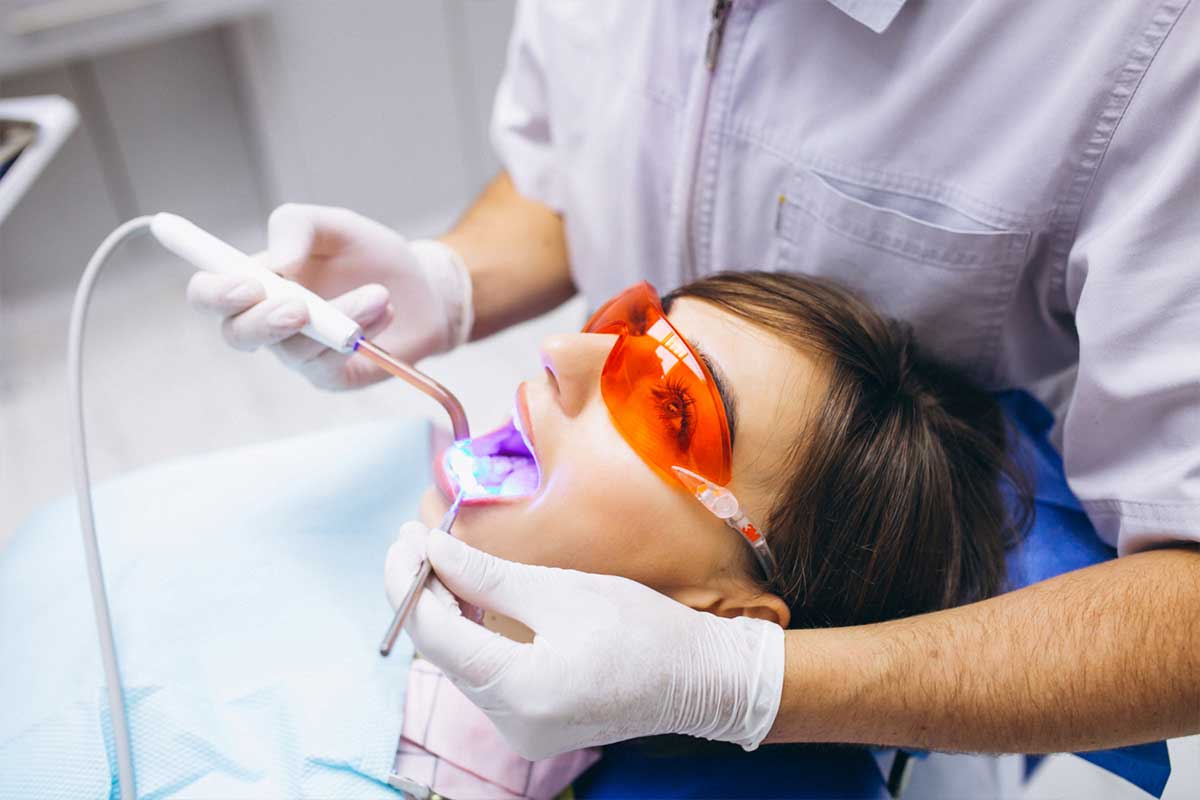Bleaching is a safe and effective way to whiten and improve your smile. Our staff at downtown dental has a vast amount of experience with most of the tooth whitening systems currently available including the laser. We do a large number of whitening cases each month and find that we have the most dramatic results with a system we refer to as Deep Bleaching™
The Procedure
There is no shortcut to getting guaranteed white teeth! Deep Bleaching™ is a combination of in office bleaching and take home trays. Your first appointment is a conditioning appointment that is done in the office for 30 minutes, followed by two weeks with the take home trays and then a 1hr final in office boost procedure. The combination bleaching process not only provides the whitest smile possible for you but allows you to maintain your whiteness through the use of the trays. However, if your desire is to only slightly whiten your teeth we usually suggest just doing the Take-Home Trays. We no longer offer the 1hr in-office laser bleaching procedure as the results are too unpredictable to justify the cost and your time.
Side Effects
Deep Bleaching™ is the most advanced formulation for safe effective teeth whitening. The product we use generates free calcium ions to help re-mineralize your teeth during the whitening process. It contains water so there is minimal sensitivity. However, some sensitivity can be experienced for the first 24 hours after the procedure, helped by Advil or Motrin.
How did my teeth get so yellow?
Over the years, like almost everyone, you’ve experienced a natural buildup of organic pigments on your teeth. Colorized proteins from coffee, tea, and other foods have simply darkened the natural whiteness of your teeth. The use of tobacco, antibiotics, and certain minerals usually speeds the darkening process. But, yellowing can be easily reversed.
What’s the difference between dentist-supervised and over-the counter treatments?
There are many differences, starting with the fact that your teeth and your own dental situation are absolutely unique. Which is why the safety of your treatment requires a dentist’s evaluation and supervision. You’ll also find that custom trays designed by the dentist will fit better and will consequently expel far less bleaching gel than the unsupervised, over-the-counter, one-size-fits-all treatment alternatives.
What about those over the counter products?
The “boil-and-bite” trays used by the over-the-counter products overlap soft tissue producing more irritation. They also feel bulky in your mouth. This results in discomfort and possible TMJ problems.
- A dentist-designed tray is less bulky.
- It conforms more closely to the natural contours of the teeth, is far more comfortable, and assures a superior result.
- You’ll find a significant difference in both the comfort and safety of dentist-designed trays vs. unsupervised over-the-counter, one-size-fits-all, “boil & bite” trays.
Who can use tooth whitening?
Nearly anyone ages nine to 90. If you want to obtain a more confident smile by improving the whiteness of your teeth, talk to us.
How does whitening work?
Your dentist will first check your teeth and gums to be sure that you begin the treatment in good dental health. Then your dentist will take an impression of your teeth in order to provide you with a custom fit plastic tray designed to hold the bleaching gel next to your teeth. Following the bleaching program your dentist suggests, you’ll notice the results quickly, as the gentle oxygenating action of the gel begins to whiten your teeth. Your dentist may choose to begin with a short in-office bleaching session.
Is there any discomfort?
There is little, if any. Some patients might feel an increased sensitivity to cold, heat, or pressure during the whitening process, but this sensitivity ends a day or two after the treatment is completed. Any note of persistent discomfort should be reported to your dentist.
Will the whitening damage my teeth?
Not at all. The whitening process will not affect your enamel, tooth structure, bonding or restorations. Whitening acts only on the molecules that carry the discoloration.
How long will it last?
Non-smokers who don’t drink coffee or tea often see little or no change over five years. But your own long-term results will depend on your habits and the specific foods you eat. Based on those variables, some patients may require a “touch-up” treatment at regular intervals.
General Tips
For sensitive teeth avoid foods with citric acid. If sensitivity persists:
- Have patient call office immediately.
- Prescribe fluoride for alternate nights.
- Purple tray after bleaching session indicates presence of zinc in fillings.
- Keep bleach refrigerated (store standard bottles upside-down).
- Do not smoke, eat or drink with tray in place.
- Pregnant women should only bleach with the agreement of their physicians.
- Bleach upper arch first.
- Wait two weeks before doing crowns or fillings.
Key Benefits of bleaching
Corrects browns, yellow and mottle tooth staining
- Works on people of any age.
- Is a near permanent solution for a “dull” smile, restoring brightness and brings a smile alive.
